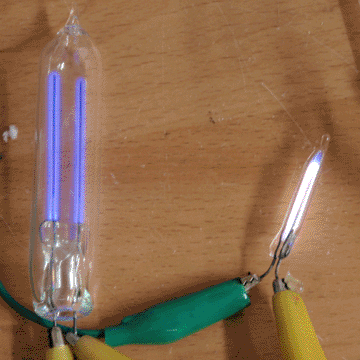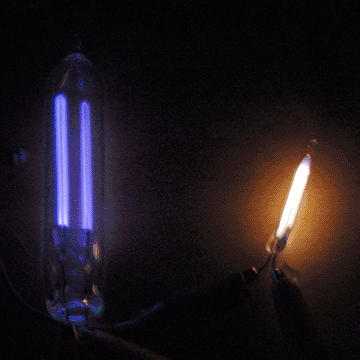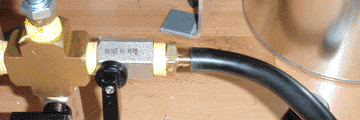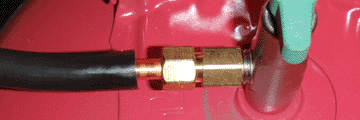

I have decided to wait until I have a working induction heater before I attempt to make another diode. Since I am still waiting on parts in the mail, I made another glow tube to experiment with helium as a light source.
I became interested in making a helium glow tube after seeing a picture of a helium discharge lamp for spectroscopy. It looked like it produced a pleasant white-orange glow and was quite bright, so I considered it as a possible light source. It is also the cheapest noble gas to get in small quantities; I found a balloon kit that contained a tank of 80% pure helium (the remaining 20% is air) for $24. Argon is probably cheaper in the long run, but it glows the same color as air and the cylinder alone would cost far more than the balloon kit.
I started by adding a hose barb to the vacuum manifold, at the inlet valve. I then used a compression fitting with a piece of copper tubing in it as a makeshift hose barb on the helium tank (I couldn't find a hose barb with a female flare connection at the hardware store). I then coated both connections in vacuum grease for a good seal and easy removal, and used a 4 foot length of thick-walled rubber hose to connect the two. The compression fitting has a tiny leak in it somewhere that limits the maximum vacuum achievable to around 50 millitorr, so I will probably have to modify it or order a proper hose barb in the future. The connections can be seen below; the hose has been slightly pulled back on each so that the connector can be seen clearly.


Due to the lack of pressure regulation on the helium tank, adjusting the pressure in the tube was very tricky. The method I settled on is wasteful, but works well. I ended up adjusting the tank valve to allow a trickle of helium to enter the vacuum manifold with the pump running, then I adjusted the pump valve to vary the pressure in the manifold and the tube. Once the tube was glowing well, I quickly shut both the inlet and vacuum valves, and sealed the tube off.
Throughout this process, the tube had been glowing a pinkish purple, not very different from previous glow tubes that contained only air. The sealed tube glowed the same color, so I considered the tube a failure and decided to destroy it by running too much current through it. In doing this though, the titanium electrodes turned red-hot and absorbed all the air, leaving only helium (and probably a small amount of argon). At this point the tube glowed white-orange, and I slowly ramped the current down to avoid cracking the glass. Pictures of the finished tube can be seen at the top of the page, where it is connected in series with the large air glow tube I made earlier. Both are powered by my usual high voltage supply, which is a variac-controlled microwave transformer, current-limited by a 2.3K power resistor on the secondary of the transformer. Connected independently, the air tube lights up at around 500V and the helium tube at around 300V.
In the end this tube turned out to be a success, and the color is pleasant to look at. I plan on making a longer neon sign style tube to see if the glow is any different, and to determine if such a tube could be used as a lamp, or at least a night-light.